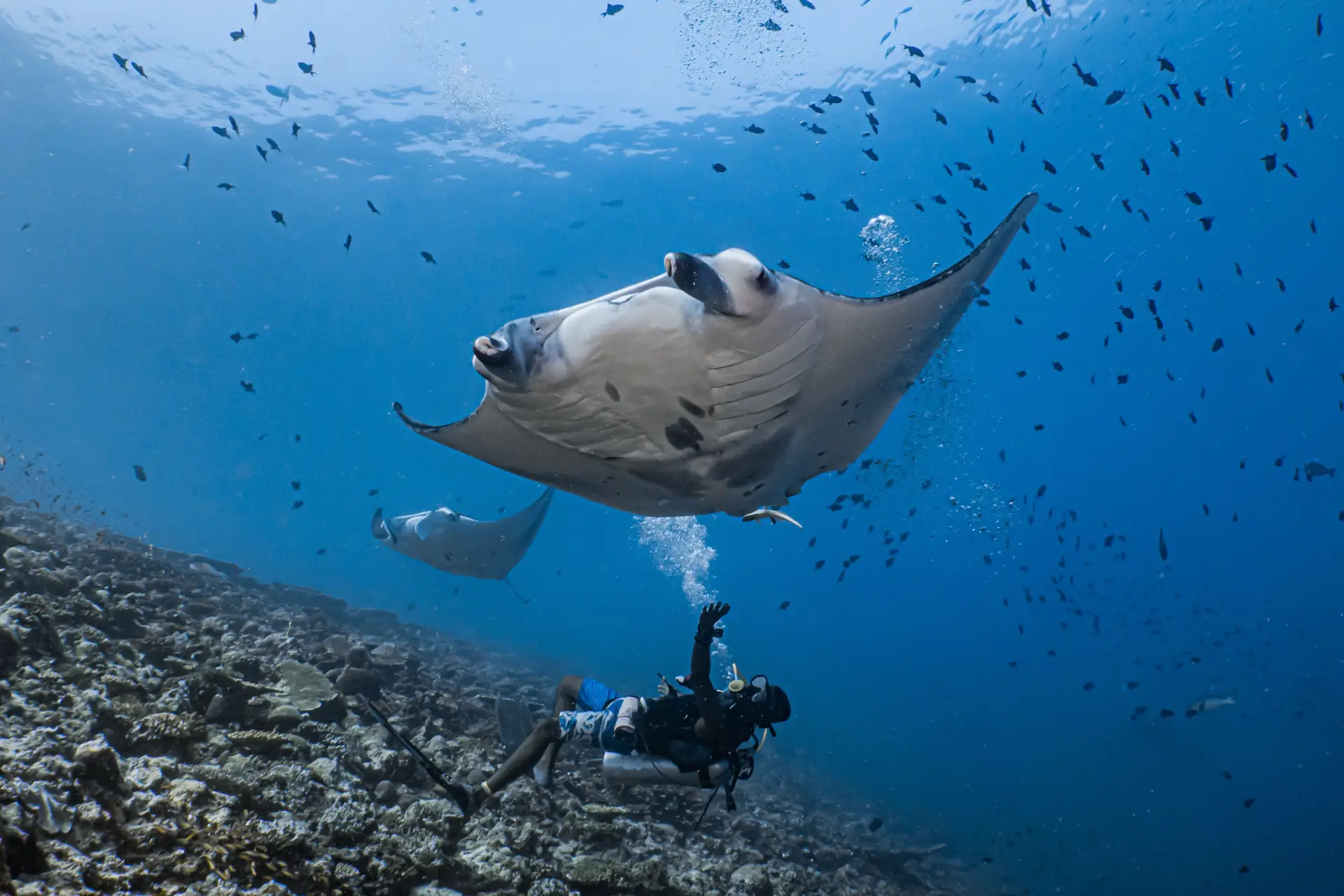The Coral Triangle Explained: Why It’s the Heart of Global Marine Biodiversity
Stretching across six nations and more than 6 million square kilometers of ocean, the Coral Triangle is often described as the “Amazon of the Seas.” It’s the epicenter of marine life on Earth, home to more coral species, reef fish, and underwater ecosystems than anywhere else in the world. For divers, scientists, and conservationists alike, the Coral Triangle isn’t just a destination — it’s a living laboratory of evolution and ecological wonder. Here’s what makes it so extraordinary and why protecting it is crucial to the planet’s future.
What and Where Is the Coral Triangle?
The Coral Triangle is a vast marine region encompassing the tropical waters of six countries: Indonesia, the Philippines, Malaysia, Papua New Guinea, Timor-Leste, and the Solomon Islands. It sits within the Indo-Pacific, a region where warm currents, nutrient flows, and geological diversity combine to create the perfect conditions for marine life to flourish. Scientists have identified this region as the global epicenter of biodiversity — a place where life has evolved in stunning abundance and complexity.
Covering just 1.6% of the planet’s ocean area, the Coral Triangle supports nearly three-quarters of all known coral species and 37% of the world’s coral reef fish. It also sustains over 120 million people who rely on its ecosystems for food, livelihood, and protection from storms and coastal erosion.
Why It’s Called the Heart of Global Marine Biodiversity
When scientists talk about “biodiversity hotspots,” they often measure how many species exist within a given area. By that measure, the Coral Triangle stands alone. Within its boundaries thrive more than 600 species of coral — compared to just 60 in the Caribbean — along with over 2,000 species of reef fish, six of the world’s seven species of marine turtles, and countless crustaceans, mollusks, and marine mammals.
Several factors make this concentration possible:
- Warm, stable sea temperatures: The Coral Triangle’s tropical climate maintains consistent temperatures ideal for coral growth year-round.
- Complex ocean currents: The meeting of the Pacific and Indian Oceans drives nutrient-rich upwellings that feed plankton blooms — the foundation of the food chain.
- Geological diversity: Volcanic islands, limestone reefs, and deep-sea trenches create a variety of habitats, from shallow lagoons to drop-offs exceeding 2,000 meters.
- Evolutionary history: Over millions of years, isolation and shifting sea levels allowed species to adapt and specialize, producing unparalleled endemism.
This combination of conditions has made the Coral Triangle a crucible of evolution — a place where new species are still being discovered with almost every scientific expedition.
Notable Regions Within the Coral Triangle
While the Coral Triangle as a whole is teeming with life, certain areas have become iconic for their unique underwater landscapes and accessibility to divers. Let’s explore a few highlights across its six nations.
1) Raja Ampat, Indonesia
Often referred to as the “crown jewel” of the Coral Triangle, Raja Ampat is home to more species of fish and coral than anywhere else on the planet. Over 550 coral species and more than 1,400 fish species have been recorded here. Diving these waters feels like entering a living kaleidoscope — every rock and coral head explodes with color and motion. Currents funnel nutrients through narrow passages like Dampier Strait, fueling ecosystems that support everything from pygmy seahorses to oceanic mantas.
2) Bohol, Philippines
The Philippines sits at the very center of the Coral Triangle, making it one of the best places in the world for underwater exploration. Around Bohol, you’ll find lush reefs and vertical walls at sites like Balicasag and Pamilacan Island. The sheer density of marine life here — from swirling jackfish to delicate nudibranchs — makes diving in the Philippines an unforgettable experience. These reefs also highlight the Coral Triangle’s role as a refuge for biodiversity and a vital source of income for local communities through sustainable tourism.
3) Kimbe Bay, Papua New Guinea
Kimbe Bay is sometimes called the “Coral Crucible” because it contains roughly 60% of all the world’s coral species within a single bay. Divers can explore untouched coral gardens, seamounts patrolled by barracuda, and WWII wrecks now covered in hard corals. The area’s isolation has protected it from overdevelopment, keeping the reefs healthy and vibrant.
4) Tun Sakaran Marine Park, Malaysia
Located in Sabah, Malaysia, this park includes a mix of mangroves, seagrass beds, and coral reefs — ecosystems that work together to sustain high biodiversity. It’s one of the best places to witness how interconnected the Coral Triangle’s habitats truly are. Shallow lagoons shelter juvenile fish and turtles that later move out to deeper reefs.
5) Solomon Islands
Remote and underexplored, the Solomon Islands combine spectacular reefs with wartime wrecks and volcanic topography. Coral coverage here is among the healthiest in the region, and the reefs host hundreds of hard and soft coral species. The lack of heavy tourism makes it ideal for divers seeking pristine, uncrowded sites.
The Coral Triangle’s Role in Global Ecology
Beyond its beauty, the Coral Triangle plays an essential role in maintaining the health of the world’s oceans. Coral reefs protect coastlines from erosion and storms, provide nurseries for fish that feed millions, and absorb vast amounts of carbon dioxide. Many species that migrate through the Indo-Pacific — including tuna, sea turtles, and whales — depend on the Triangle’s reefs and seagrass beds as breeding or feeding grounds.
In essence, the Coral Triangle acts as a heartbeat for marine ecosystems worldwide. When its reefs thrive, they help stabilize global fish stocks and ocean chemistry. But when they decline, the effects ripple far beyond Southeast Asia.
Threats Facing the Coral Triangle
Despite its resilience, the Coral Triangle faces mounting threats from human activity and climate change. Rising sea temperatures are causing widespread coral bleaching, while coastal development, destructive fishing, and pollution continue to stress local ecosystems. Overfishing of key species — from groupers to sharks — disrupts ecological balance, and sediment runoff from agriculture smothers corals in many areas.
Climate models predict that without intervention, more than half of the Coral Triangle’s coral reefs could be lost by the end of the century. However, thanks to local conservation efforts, community-based marine protected areas, and increasing global awareness, there is still hope for recovery and resilience.
Conservation Efforts and Hope for the Future
The Coral Triangle Initiative on Coral Reefs, Fisheries and Food Security (CTI-CFF) is a multinational partnership established in 2009 to address these challenges collaboratively. The initiative promotes sustainable fishing, marine protected areas, and climate adaptation strategies across the six Coral Triangle countries.
Local projects are equally important. In the Philippines and Indonesia, community-led marine sanctuaries have shown remarkable success in restoring fish populations and coral cover. Divers and ecotourism operators are also playing a role by supporting reef monitoring programs, practicing responsible diving, and educating visitors on reef-safe behavior.
Technology is beginning to help as well — satellite mapping, underwater drones, and coral DNA sequencing are providing scientists with better tools to monitor and protect this critical ecosystem.
Why the Coral Triangle Matters to Divers
For scuba divers, the Coral Triangle represents the pinnacle of underwater exploration. It’s where the greatest diversity of life on Earth meets accessible, warm-water diving. Whether you’re gliding over the coral-covered slopes of Bohol, drifting past manta rays in Raja Ampat, or photographing rare macro species in Papua New Guinea, each dive here is an immersion into the planet’s biological heritage.
But with that privilege comes responsibility. Every dive should be low-impact — excellent buoyancy, no touching, and an awareness of how even small actions affect fragile ecosystems. Supporting eco-certified dive operators, avoiding single-use plastics, and using reef-safe sunscreen all contribute to preserving the Coral Triangle for future generations.
Final Thoughts
The Coral Triangle is far more than a collection of reefs — it’s the living center of our planet’s marine biodiversity. Its reefs fuel global fisheries, regulate climate, and inspire millions of people who experience their beauty firsthand. Yet its future depends on action now: responsible tourism, sustainable fisheries, and conservation at both local and global scales.
For divers, the message is simple — visit, learn, and protect. The Coral Triangle’s wonders remind us of the delicate balance that sustains life beneath the surface and the vital role we all play in keeping that balance intact. As we look toward 2026 and beyond, there’s no better time to explore, appreciate, and advocate for the beating heart of the ocean — the Coral Triangle.

